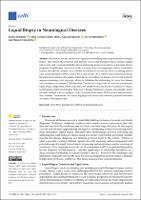Liquid Biopsy in Neurological Diseases
Author
Date
2023-07-22Permanent link
https://hdl.handle.net/11351/10129DOI
10.3390/cells12141911
ISSN
2073-4409
WOS
001035122300001
PMID
37508574
Abstract
The most recent and non-invasive approach for studying early-stage biomarkers is liquid biopsy. This implies the extraction and analysis of non-solid biological tissues (serum, plasma, saliva, urine, and cerebrospinal fluid) without undergoing invasive procedures to determine disease prognosis. Liquid biopsy can be used for the screening of several components, such as extracellular vesicles, microRNAs, cell-free DNA, cell-free mitochondrial and nuclear DNA, circulating tumour cells, circulating tumour DNA, transfer RNA, and circular DNA or RNA derived from body fluids. Its application includes early disease diagnosis, the surveillance of disease activity, and treatment response monitoring, with growing evidence for validating this methodology in cancer, liver disease, and central nervous system (CNS) disorders. This review will provide an overview of mentioned liquid biopsy components, which could serve as valuable biomarkers for the evaluation of complex neurological conditions, including Alzheimer’s disease, Parkinson’s disease, amyotrophic lateral sclerosis, multiple sclerosis, epilepsy, stroke, traumatic brain injury, CNS tumours, and neuroinfectious diseases. Furthermore, this review highlights the future directions and potential limitations associated with liquid biopsy.
Keywords
Liquid biopsy; MicroRNA; Neurological diseasesBibliographic citation
Malhotra S, Martín Miras MC, Pappolla A, Montalban X, Comabella M. Liquid Biopsy in Neurological Diseases. Cells. 2023 Jul 12;12(14):1911.
Audience
Professionals
This item appears in following collections
- CEMCAT - Articles científics [161]
- HVH - Articles científics [4471]
The following license files are associated with this item:

 Private area
Private area Contact Us
Contact Us








